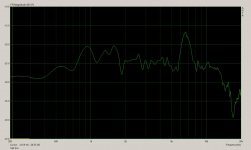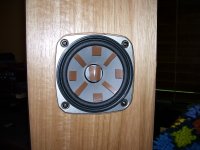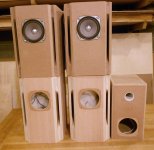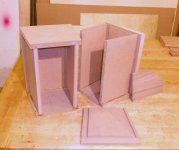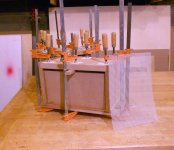What it takes to tame this puppy. Yea, it sounds a lot smoother too.
This is a 1M, 3.5ms gate, so ignore all LF.
Yikes, that's some peak in the original response - nearly 10dB ? No wonder it was hard on the ears... 😱
Good results for a first try but one suggestion I'd make is to turn the long strips (on the cone itself) 90 degrees, and if necessary shorten them slightly to fit. I didn't find orientating them the way you show worked very well, placing them parallel to the outside perimeter worked better for me. When they're parallel to the perimeter adjusting the distance from the centre/edge controls what frequency they damp - closer to the perimeter is lower in frequency, closer to the middle is higher.
This way you can target a peak specifically, provided its within a certain frequency range. Too far one way or the other and you'll just put a dip in the response next to the peak. (Think of it like tuning the centre frequency of a notch filter...) I'd leave the square ones where they are for the moment and make sure the other strips on each opposite side are symmetrically placed so the centre of mass stays aligned...so if you move one closer to the centre move its 180 degree opposite to the same radius.
Last edited:
This was a quick and dirty test that is removable. This weather strip has very poor adhesion. As to not load the forum with too many pictures, the denser black foam I have did a better job on the dustcap resonances. With no scales, I can't compare black to tan for mass. I tried the black ( thinner but denser) in two rings around the outside and it was no where near as good. This was the best of about 20 configurations.
So, I have basically confirmed the problem and the approach. Next is suitable materials. I need to go get a pile of 50 cent paper drivers to test various things I could use, from windshield seal, PVA, dip-it, laytex paint,rubber cement, ( dusted with microspheres) Zig-2, all kinds of things I can think of. I want to have at least a little clue before I damage the Fostex. I would have no doubts on Planet-10's drivers or buying then unheard. Who knows, I might even buy a pair myself. That dust cap is evil, even with the crease in it.
Without BSC, it is still out of balance, just not as harsh. I'm going to beat this thing into submission, which should help out Doug with all those pretty boxes he is building.
So, I have basically confirmed the problem and the approach. Next is suitable materials. I need to go get a pile of 50 cent paper drivers to test various things I could use, from windshield seal, PVA, dip-it, laytex paint,rubber cement, ( dusted with microspheres) Zig-2, all kinds of things I can think of. I want to have at least a little clue before I damage the Fostex. I would have no doubts on Planet-10's drivers or buying then unheard. Who knows, I might even buy a pair myself. That dust cap is evil, even with the crease in it.
Without BSC, it is still out of balance, just not as harsh. I'm going to beat this thing into submission, which should help out Doug with all those pretty boxes he is building.
Back to the original question: " What is the attraction ?"
Wide ranger drivers, (in my experience the Fostex 108sigma that sounds quite flat with no BSC, as a mid-tweeter with helper woofer in FAST configuration) do sound more realistic and "alive" than a 3-way with super low distortion drivers like the SEAS 8" Mag driver that is used in Orion and a ribbon tweeter. I used no passive components but miniDSP and active SS amplification. Although the smoothness of the SEAS cannot be matched by the 108...perhaps due to the ruler-flatness and low distortion of the SEAS. Still the 108 sounds more "lively". Perhaps the 108 is more dynamic with sharper transients due to its higher efficiency and strong magnet with a light paper cone. Strangely the smaller Alpair ( I only have tried the Alpair 6M) although with higher xmax and bass capapability even when used in a FAST configuration does not sound as lively as the 108...others may have differing opinions though. I also find that the fostex 108 has more extended treble response than the even smaller diameter Alpair 6M.
I guess the stronger magnet and higher efficiency of the 108 make it livelier than the Alpair 6M in a FAST design. Herein I believe lies the magic of a high efficiency wide ranger....of course with a helper woofer.
Wide ranger drivers, (in my experience the Fostex 108sigma that sounds quite flat with no BSC, as a mid-tweeter with helper woofer in FAST configuration) do sound more realistic and "alive" than a 3-way with super low distortion drivers like the SEAS 8" Mag driver that is used in Orion and a ribbon tweeter. I used no passive components but miniDSP and active SS amplification. Although the smoothness of the SEAS cannot be matched by the 108...perhaps due to the ruler-flatness and low distortion of the SEAS. Still the 108 sounds more "lively". Perhaps the 108 is more dynamic with sharper transients due to its higher efficiency and strong magnet with a light paper cone. Strangely the smaller Alpair ( I only have tried the Alpair 6M) although with higher xmax and bass capapability even when used in a FAST configuration does not sound as lively as the 108...others may have differing opinions though. I also find that the fostex 108 has more extended treble response than the even smaller diameter Alpair 6M.
I guess the stronger magnet and higher efficiency of the 108 make it livelier than the Alpair 6M in a FAST design. Herein I believe lies the magic of a high efficiency wide ranger....of course with a helper woofer.
What it takes to tame this puppy. Yea, it sounds a lot smoother too.
This is a 1M, 3.5ms gate, so ignore all LF.
What a great result.
Wide ranger drivers, (in my experience the Fostex 108sigma that sounds quite flat with no BSC, as a mid-tweeter with helper woofer in FAST configuration) do sound more realistic and "alive" than a 3-way with super low distortion drivers like the SEAS 8" Mag driver that is used in Orion and a ribbon tweeter. I used no passive components but miniDSP and active SS amplification. Although the smoothness of the SEAS cannot be matched by the 108...perhaps due to the ruler-flatness and low distortion of the SEAS. Still the 108 sounds more "lively". Perhaps the 108 is more dynamic with sharper transients due to its higher efficiency and strong magnet with a light paper cone. Strangely the smaller Alpair ( I only have tried the Alpair 6M) although with higher xmax and bass capapability even when used in a FAST configuration does not sound as lively as the 108...others may have differing opinions though. I also find that the fostex 108 has more extended treble response than the even smaller diameter Alpair 6M.
I love my FE108e Sigmas (modified by Dave) to death. They sound incredibly realistic, and when not asked to go too low actually can get very loud. I have them in Aikos so the horn loading helps with that.
They have excellent high end, solid response all the way to 20000 Hz
Its not as flat as a ribbon or what have you but it sure does sound good
TVR, looks like you could paint on some RVT 118 on the Alum. dome; if you don't like it you could pull it off (that stuff yellows over the years...btw).
The MFD/angle/cork boxes sure knock out the back wave down (should be done soon).
The MFD/angle/cork boxes sure knock out the back wave down (should be done soon).
Back to the original question: " What is the attraction ?"
Wide ranger drivers, (in my experience the Fostex 108sigma that sounds quite flat with no BSC, as a mid-tweeter with helper woofer in FAST configuration) do sound more realistic and "alive" than a 3-way with super low distortion drivers like the SEAS 8" Mag driver that is used in Orion and a ribbon tweeter. I used no passive components but miniDSP and active SS amplification. Although the smoothness of the SEAS cannot be matched by the 108...perhaps due to the ruler-flatness and low distortion of the SEAS. Still the 108 sounds more "lively". Perhaps the 108 is more dynamic with sharper transients due to its higher efficiency and strong magnet with a light paper cone. Strangely the smaller Alpair ( I only have tried the Alpair 6M) although with higher xmax and bass capapability even when used in a FAST configuration does not sound as lively as the 108...others may have differing opinions though. I also find that the fostex 108 has more extended treble response than the even smaller diameter Alpair 6M.
I guess the stronger magnet and higher efficiency of the 108 make it livelier than the Alpair 6M in a FAST design. Herein I believe lies the magic of a high efficiency wide ranger....of course with a helper woofer.
From the charts, the smaller Fostex do not have the resonance quite as bad. Of course, when speaking of resonance, the Seas is horrible. You need very steep and low crossover for it. Don't know of a ribbon I would use at 1K. Actually, I don't know of any tweeter that low. Maybe a small full range for a mid? 😀
Nice surprise
It worked 😀 I was stating to wonder if this was going to be a waste of time.
However, the bass is much richer, more defined. I think the angle helps the bass "bubble" better. Maybe I just like angled MDF cabinets, but they are sounding nice.
Waring! The bass on these speakers was always an issue; now I can't believe this is the same woofer. E.G. I put the Fostex box in pic, they really do much of anything....bla
I think I've made it over the bass hurdle, now some help with the breakup?
It worked 😀 I was stating to wonder if this was going to be a waste of time.
However, the bass is much richer, more defined. I think the angle helps the bass "bubble" better. Maybe I just like angled MDF cabinets, but they are sounding nice.
Waring! The bass on these speakers was always an issue; now I can't believe this is the same woofer. E.G. I put the Fostex box in pic, they really do much of anything....bla
I think I've made it over the bass hurdle, now some help with the breakup?
Attachments
Dougbo,
Good to know that there's been progress!
So that we all are on the same page, can you please summarize what previous version(s) are you are comparing the current build to? A brief chronological walkthrough on your efforts/expereinces on this particular project would be nice too.
- Zia
Good to know that there's been progress!
So that we all are on the same page, can you please summarize what previous version(s) are you are comparing the current build to? A brief chronological walkthrough on your efforts/expereinces on this particular project would be nice too.
- Zia
Ordered some $2 speakers to test dampening materials on. I may have found something. Also the parts for BSC. (which will make the bass seem far better balanced)
It worked 😀 I was stating to wonder if this was going to be a waste of time.
However, the bass is much richer, more defined. I think the angle helps the bass "bubble" better. Maybe I just like angled MDF cabinets, but they are sounding nice.
Waring! The bass on these speakers was always an issue; now I can't believe this is the same woofer. E.G. I put the Fostex box in pic, they really do much of anything....bla
I think I've made it over the bass hurdle, now some help with the breakup?
cute and clever - and someone could have said "toleyaso" about the Fostex "recommended" boxes
next stop- laminated bamboo plywood 😉
Ordered some $2 speakers to test dampening materials on. I may have found something. Also the parts for BSC. (which will make the bass seem far better balanced)
BSC (at least 4mh) and similar filters (about 1.4mh) will be great fun with full range drivers. Maybe just think of it this way: The bigger one increases the bass proportion and the smaller one increases the baritone proportion. To increase the midrange you can put resistors parallel with the inductors. To increase the highest treble, you can put tiny polyester caps parallel with the inductors. To increase the mid-treble you can put RC's parallel with the inductors. To decrease noise of the inductors, you can put a high value cap, like approximately 47nF (size depends on inductor) little polyester dip cap parallel with the inductor to damp the inductor itself.
The foam is great for damping that dust cap resonance, but you'll discover a need to have the foam very thin at the very center for about 1/4" (of thin) if not using a helper tweeter; meanwhile, the filters outlined above can adjust your solid state amplifier to happily drive your full range speaker without shouting/peakish issues.
As far as the foam on the speaker driver's cone, you may desire omit some that after you've installed the filters because too much foam is like a blanket--relaxing indeed but not penultimately clear. So, I suggest to use the filters to cut power to the problem prior to considering covering it. But you did a great job on discovering where to apply the foam to damp cone resonances and that can be re-deployed for fine tuning after working with the filters.
Basically, Kudos!!
And thanks for starting this thread that has so much good documentation on managing full range speaker drivers.
2.6mH, 7 Ohms. Depends on the box of course. Once we get the mechanical resonance issues dealt with, yes, a small cap to bypass the choke could bring up the top octave a tad. We will give it a try. A "simple" full range can get darn complicated pretty quick. Of course, the better the driver, the less complicated the network needs to be. Just think how much they learned back at the BBC trying to make a B110 and T27 behave!
The foam was just to verify the problem. It is totally impractical. It happens to be very low tack, so it did not damage the driver. I don't have a case of them to play with. Fortunately Nonsuch has a case of these little Sony's...
Did my first layer of doping to a Sony which also has horrendous 6K peaks. It has other problems, but it is a 69 cent driver. They are straight side cones with light doping on one side, so the effect of the foam was only about 3 dB at 6K and about a dB at 500. I expect to do far better with my stuff applied directly.
Also making a test sheet of paper with all the dope materials I bought. Back to the "waiting for the paint to dry" literally. 🙂
The foam was just to verify the problem. It is totally impractical. It happens to be very low tack, so it did not damage the driver. I don't have a case of them to play with. Fortunately Nonsuch has a case of these little Sony's...
Did my first layer of doping to a Sony which also has horrendous 6K peaks. It has other problems, but it is a 69 cent driver. They are straight side cones with light doping on one side, so the effect of the foam was only about 3 dB at 6K and about a dB at 500. I expect to do far better with my stuff applied directly.
Also making a test sheet of paper with all the dope materials I bought. Back to the "waiting for the paint to dry" literally. 🙂
Been meaning try a BSC; simply use the 2.6mh inductor with a 7ohm resistor - parallel?
The goal is to decrease the middle - just a bit.
The goal is to decrease the middle - just a bit.
Yes and no. 2.6 and 7 is about right for the width of your baffle. Closer to the test box I built. They go in parallel with each other and the pair in series with the driver. As always, this is a starting point where we start with both methods of highly flawed measurements: instrumentation and ears.
The goal is to reduce everything above the point where the baffle transitions from 180 degree radiation to 360. In a perfect world, a sphere in free space, it is a simple calculation based on the diameter of the sphere. We don't live in perfect so we start with what The Edge recommends and work from there. The result is much more apparent bass. How it will sound could also be effected by the lack of the top octave, so the amount of reduction may need to be trimmed to balance it out. If you put speakers up against a wall, then it is a lot more complicated as you never get full 360 radiation. AR made a speaker back in the 60's that actually had a switch for free, wall and corner placement. An excellent idea no one understood. AR 10 if I remember. Here is a good test. Listen in free space, then listen with them against the wall.
I have been over on the PASS forum for a bit as I was considering an upgrade to an older Pass designed amp, or even jump off a cliff and build an F5. Anyway, with class A, one really attempts to get the most in efficiency from their speakers. You can imagine how reducing everything above a couple hundred Hz by 6 dB is not a really attractive idea when dealing with 25W amps. I mention this just to point out that everything in speaker design has only one correct answer; "It depends".
PS, remember how Paul Klipsch always said the world needs a good 10W amp? He built CORNER horns. 1-pi radiation instead of 4. I may not like his speakers, but he knew exactly what he was doing.
The goal is to reduce everything above the point where the baffle transitions from 180 degree radiation to 360. In a perfect world, a sphere in free space, it is a simple calculation based on the diameter of the sphere. We don't live in perfect so we start with what The Edge recommends and work from there. The result is much more apparent bass. How it will sound could also be effected by the lack of the top octave, so the amount of reduction may need to be trimmed to balance it out. If you put speakers up against a wall, then it is a lot more complicated as you never get full 360 radiation. AR made a speaker back in the 60's that actually had a switch for free, wall and corner placement. An excellent idea no one understood. AR 10 if I remember. Here is a good test. Listen in free space, then listen with them against the wall.
I have been over on the PASS forum for a bit as I was considering an upgrade to an older Pass designed amp, or even jump off a cliff and build an F5. Anyway, with class A, one really attempts to get the most in efficiency from their speakers. You can imagine how reducing everything above a couple hundred Hz by 6 dB is not a really attractive idea when dealing with 25W amps. I mention this just to point out that everything in speaker design has only one correct answer; "It depends".
PS, remember how Paul Klipsch always said the world needs a good 10W amp? He built CORNER horns. 1-pi radiation instead of 4. I may not like his speakers, but he knew exactly what he was doing.
Construction
Just a an idea or two..........
Let's just say we only had one sheet of 1/2 mdf to work with.
> Could cut double pieces for back = the 1"
> Could cut smaller keystones for tops and bottoms, won't need groves (pic)
> Could cut horn shape vent strips (might not be as strong as wood)
[Odougbo will use oak or better next time]
Btw, I see the FF85's are being discussed....hummmmmm


Just a an idea or two..........
Let's just say we only had one sheet of 1/2 mdf to work with.
> Could cut double pieces for back = the 1"
> Could cut smaller keystones for tops and bottoms, won't need groves (pic)
> Could cut horn shape vent strips (might not be as strong as wood)
[Odougbo will use oak or better next time]
Btw, I see the FF85's are being discussed....hummmmmm



Attachments
I read a review of a full ranger in Stereophile.
The mfr had taken the lowther driver ideals and made their own driver.
What was interesting was the cabinet, made by a piano maker of some history Schimmel, had particleboard components in it.
Apparently there are some panels in a folded horn that while structural dont contribute to the sound.
Other panels are tonewoods or ply but i found the use of "particleboard" interesting.
The mfr had taken the lowther driver ideals and made their own driver.
What was interesting was the cabinet, made by a piano maker of some history Schimmel, had particleboard components in it.
Apparently there are some panels in a folded horn that while structural dont contribute to the sound.
Other panels are tonewoods or ply but i found the use of "particleboard" interesting.
- Status
- Not open for further replies.
- Home
- Loudspeakers
- Full Range
- What's the attraction?
